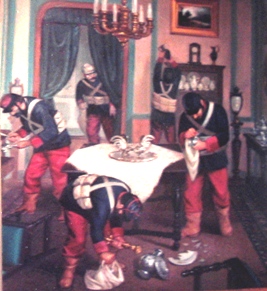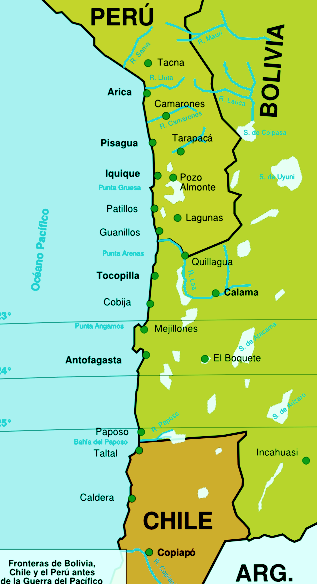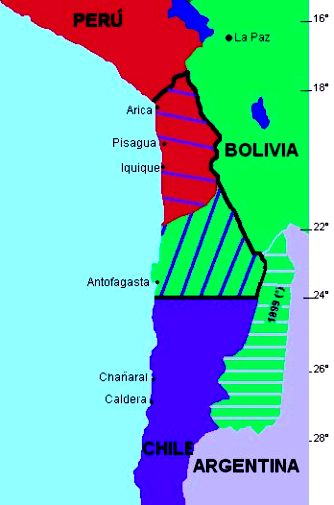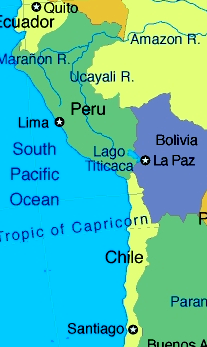Theft-oriented Chile declares war on Peru on April the 5th, 1879
Four-year long war--robbery, murder, terrorism in the process. Territorial mutilation.
 |
| Chilean soldiers looting in Lima, 1881. |
Political factors
Chile’s declaration of war on Peru was not a sudden event, it had its historical background with many facets, all of them enlightening. The origin and development of the war can be explained by the long standing Chilean will of seizing lands of Peru and Bolivia, illegal endeavour made easier by the fact that the attacked countries, Peru and Bolivia, were most of the time immersed in chaos, civil wars, ringleaders’ struggles1, revolutions, counter-revolutions, squandering of the national wealth obtained from the exportation of guano and saltpetre, deterioration of productive activity, economical and financial crisis, political instability, etc.
 |
Whereas Peruvians and Bolivians, impervious to the danger of land-robbery that Chile had in store, lived in a continuous social and political turmoil, and the countries and the people impoverished by the day, Chilean political and military leaders bought modern military hardware and came to the right conclusion that that picture of chaos and social and economical weaknesses would not change a bit, so Bolivia and Peru were in for an all-out Chilean invasion aimed at stripping Bolivia and Peru of large chunks of territory. Without taking appropriate measures, without purchasing modern military equipment, Peruvian and Bolivian politicians, just in order to assuage public concern, worked out and signed in 1873 a defensive alliance, which--due to both countries’ economic fragility, political instability and extreme military weakness--was merely symbolic, just a delusion. By invading Bolivia and Peru, Chile, South America’s fratricidal country2, proved right those who saw the danger and warned to no avail.
Peru as a target. Chilean enterprises take over Bolivian coastal province paving the ground for war
So as to carry out their plans, the filthy Chilean robbers had set their sights, in the first place, on Bolivia (at the time Peru and Chile shared no border, Bolivia lay in-between). Antofagasta was Bolivia’s littoral province, rich in saltpetre, a commodity in high demand in Europe. Then the Chilean fifth column (the entrepreneurs) began to pour in in great numbers. Inasmuch as it was very difficult to travel from La Paz, the Bolivian capital, to Antofagasta, the Bolivian central government had only a loose control over Antofagasta.
 |
The Chilean invasion on Bolivia was unleashed in February 1879, but, as we have pointed out, the arrival to Antofagasta of fifth columnist Chilean entrepreneurs had taken place years before, and they were, so to speak, the beachhead of the Chilean army, which later on invaded Antofagasta under the pretext of “protecting” their fellow countrymen3. The Chileans knew that Peru went through problems similar to those of Bolivia. They also knew that in 1872-1874 the Peruvian government, on the advice of prochilean politicians and military men, had refused to buy modern warships--the Peruvian servants of Chile held the view that the acquisition of modern weaponry by Chile posed no threat to Peru (and Peru did not even have a border with Chile, they said).
Military matters
To Chilean robbers things were crystal-clear--in Antofagasta Bolivia did not have an army4 nor a single warship; Peru was also ill-armed, had ageeing warships, obsolete artillery and an assortment of outdated rifles (and of different calibres at that)5. Cognizant of this reality, the fratricidal Chileans foresaw, and rightly so, that the invasion would smoothly go from Bolivia to Peru.
Under these circumstances, when on February the 14th, 1879, theft-oriented Chile began the invasion of the Bolivian coast, Peru reacted with a diplomatic move, not with a military one. Peru sent minister José Antonio de Lavalle to Chile to mediate, to ask Chile to withdraw its troops from Bolivian land. The Chilean rats replied by saying that Peru should stay neutral, something Peruvians were loath to do because they had a defensive alliance to comply. Given the premeditation and war-readiness of the Chilean criminals, given the long standing Chilean goal of robbing Peru and Bolivia of their coastal territories, Chile took advantage of the Peru-Bolivia defensive alliance and decided that if it had invaded Bolivia then had to declare war on Peru on account of its reluctance to stay neutral.
 |
The logical consequence of this politico-diplomatic situation is that Chilean murderers and terrorists declared war on Peru on April the 5th 1879 feeling secure that--because of the structural weaknesses of Peru and Bolivia and because of their military fragility--they had a guaranteed victory. This war drew the attention of military men from all over the world who wanted to see in action Chile’s state-of-the-art warships, German Krupp guns and rifles. Taking into consideration the clear Chilean edge in weaponry, most military experts thought that Peru’s military force was likely to collapse in a matter of weeks--or months, at the latest.Against all odds, resorting to guerrilla warfare, Peruvians held out until 1883 (four years!).
_________________________
1 In Peru and Bolivia there were times in which two or three civilian or military ringleaders simultaneously claimed to be the president of the country.
2 Chile not only attacked Peru and Bolivia; it also robbed Argentina of some territory and, to top it off, helped the British in the Falklands War (1982), in order to make sure Argentina was utterly defeated.
3 Chilean entrepreneurs complained to their government in Santiago that Bolivia had raised the tax on every quintal (100 lbs) of exported saltpetre.
4 As the looting and terrorist Chilean army invaded Antofagasta, it was confronted by Eduardo Avaroa, a civilian, not by the tiny 40 men strong Bolivian garrison. Avaroa and a handful of civilians fought gallantly but were slaughtered by the Chilean thieves.
5 This detail is critical. To any army it is very difficult and bothersome to supply ammunition to the soldiers if they use weapons of different make and calibre.
